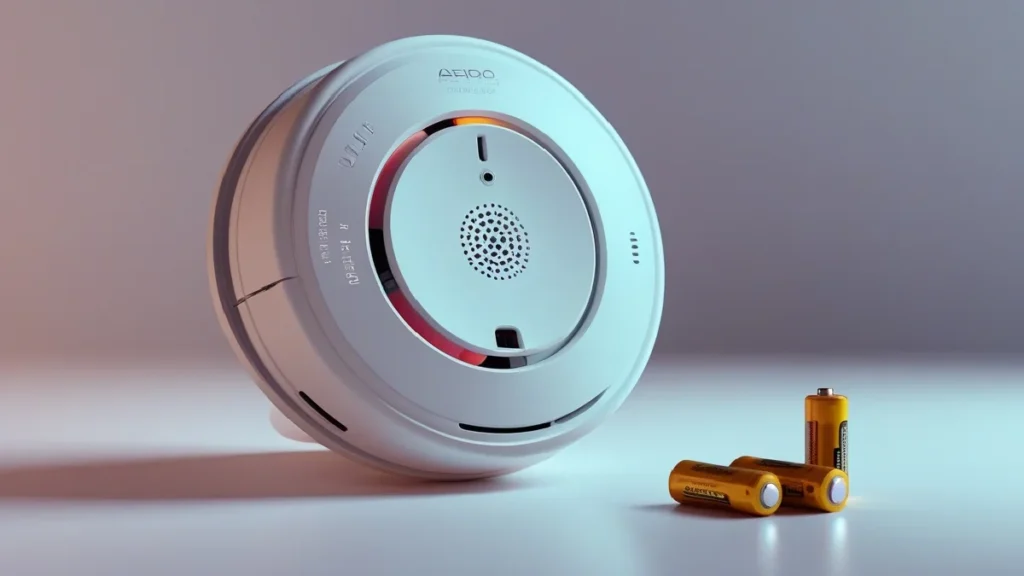Smoke Detector with Battery: The Essential U.S. Guide + Step-by-Step Instal
If you want a simple, reliable way to protect your family, a smoke detector with battery is hard to beat. It works during power outages, installs in minutes, and meets modern safety standards.

This guide shows you what to buy, where to place it, and how to install and maintain a smoke detector with battery—so it’s ready when it matters most.
What to Buy (U.S. standards you can trust)
- Certifications
- Look for UL 217 listing and follow NFPA 72 recommendations.
- Sensor type
- Photoelectric: Best for slow, smoldering fires (bedrooms, living rooms).
- Ionization: Faster response to flaming fires (more prone to cooking false alarms).
- Dual-sensor: Balanced, all-around protection.
- Battery type
- Replaceable (9V/AA): Budget-friendly; replace at least once a year or when it chirps.
- 10-year sealed lithium: Low maintenance; replace the entire unit at end of life.
- Helpful features
- Hush/silence button, wireless interconnect (so all alarms sound together), smart app alerts, nightlight, and combination smoke + CO for homes with fuel-burning appliances or an attached garage.
- Trusted U.S. brands
- First Alert, Kidde, Google Nest Protect (battery version).
Where to Install (aligned with NFPA best practices)
- Place at least one alarm on every level, including the basement.
- Install inside every bedroom and outside each sleeping area (hallways).
- Near stairways and main living areas.
- Keep at least 10 feet from cooking appliances to reduce nuisance alarms.
- Avoid bathrooms, garages, and areas with heavy steam or exhaust.
- Mounting specifics
- Ceiling: At least 4 inches from the nearest wall.
- Wall: 4–12 inches down from the ceiling.
- Sloped ceilings: Within 3 feet of the peak, not in the top 4 inches.
- Interconnect
- Prefer interconnected alarms. If you can’t hardwire, choose wireless interconnected battery models.
Tools and Supplies
- Smoke detector with battery (plus spare batteries if not sealed)
- Drill or screwdriver, included screws/anchors
- Pencil, tape measure, step ladder
- Marker to note install date
Step-by-Step: Install a Smoke Detector with Battery
- Plan the location
- Choose a code-friendly spot away from corners, vents, windows, and ceiling fan drafts.
- Power the unit
- Insert the battery (match +/−) or pull the activation tab on 10-year sealed models.
- Mount the bracket
- Hold the plate to the ceiling or high on the wall; mark holes.
- Drill pilot holes if needed; use drywall anchors for a secure fit.
- Screw the bracket firmly in place.
- Attach the alarm
- Twist or click the alarm onto the bracket until it locks.
- Test immediately
- Press and hold the Test button until the siren sounds. Recheck battery orientation if it doesn’t.
- Label and log
- Write the install month/year on the unit. Set a yearly reminder for battery replacement (if not sealed).
- Educate your household
- Let everyone hear the alarm and practice a 2-minute escape plan with two ways out of each room.
Maintenance Schedule
- Monthly: Press Test on every alarm.
- Quarterly: Vacuum around vents with a soft brush. Don’t spray cleaners.
- Annually: Replace batteries in non-sealed units; review your escape plan.
- Every 10 years: Replace the entire alarm (sensors degrade over time).
Troubleshooting (decode the sounds)
- Chirp every 30–60 seconds: Low battery or loose battery drawer. Replace/reseat battery.
- Two chirps or “END” indicator: End of life. Replace the whole unit.
- Continuous or 3-beep pattern: Treat as a real alarm. Investigate and evacuate if needed.
- Frequent kitchen false alarms: Move the alarm 10+ ft from the stove and use photoelectric models. Use Hush when safe.
- Renovation dust: Temporarily cover with a shower cap while sanding/painting; remove immediately after. Never disable long-term.
Quick Notes on Laws and Codes (not legal advice)
- Many states/cities require 10-year sealed battery alarms in certain scenarios (e.g., California, New York).
- Newer construction often requires interconnection.
- Rentals may have additional placement and maintenance rules.
- Always verify with your local code authority or fire marshal.
Safety Add-ons
- Carbon monoxide alarms: Required in most homes with fuel-burning appliances or attached garages; install outside sleeping areas and on every level.
- Combination smoke + CO units: Good for hallways/apartments.
- Smart alerts: Useful if you travel or manage rentals.
Printable Homeowner Checklist
- Install at least one smoke detector with battery on every level.
- Place one inside each bedroom and outside sleeping areas.
- Keep 10 ft from cooking appliances.
- Test monthly; vacuum dust quarterly.
- Replace batteries yearly (if not sealed).
- Replace the entire alarm every 10 years.
- Practice a 2-minute escape plan.
FAQs
How often should I replace the battery in a smoke detector with battery?
How often should I replace the battery in a smoke detector with battery?
Replace it at least once a year or when you hear a 30–60 second chirp. Test monthly. For 10-year sealed lithium models, replace the entire unit at end of life.
Where should I not install a smoke detector with battery?
Where should I not install a smoke detector with battery?
Avoid kitchens (keep 10 ft away), bathrooms (steam), garages (exhaust/temps), near HVAC registers, windows, and ceiling fans.
Why is my smoke alarm chirping?
Why is my smoke alarm chirping?
Low battery, loose battery drawer, end-of-life indicator, dust buildup, or temperature swings. Replace/reseat the battery, vacuum vents, or replace the unit if old.
Sources and References
- NFPA 72 (National Fire Alarm and Signaling Code): https://www.nfpa.org
- USFA Smoke Alarms: https://www.usfa.fema.gov
- CPSC Fire Safety Guidance: https://www.cpsc.gov
- UL 217 Smoke Alarms: https://www.ul.com
Author and Review
- Written by: Alex Morgan, Home Safety Specialist. I help U.S. homeowners choose and maintain life-safety devices with practical, code-aware advice.
- Reviewed by: Jamie Lee, Licensed Fire Inspector (CFI). Ensured NFPA-aligned placement and maintenance guidance.
- Disclaimer: General guidance only; verify local codes and your manufacturer’s manual.
- Learn more: smoke detector with battery | Facebook.


Leave a Reply